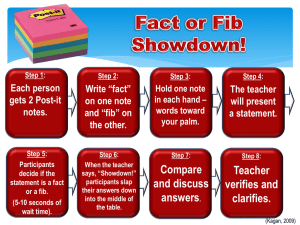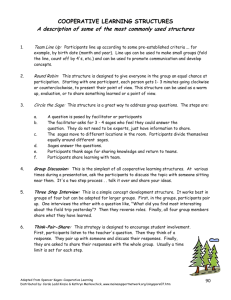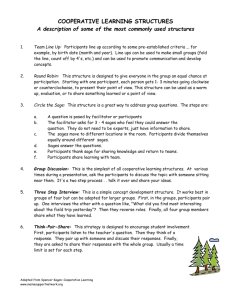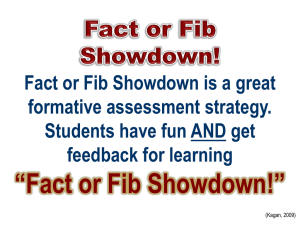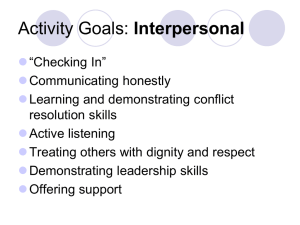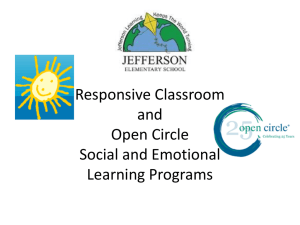PowerPoint - Pittsburg State University
advertisement
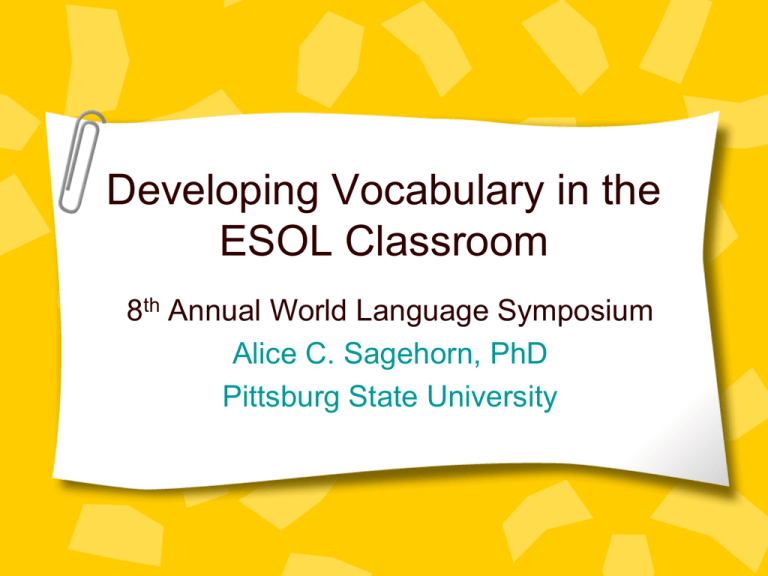
Developing Vocabulary in the ESOL Classroom 8th Annual World Language Symposium Alice C. Sagehorn, PhD Pittsburg State University What is an ELL? English Language Learner Limited English Proficient A student aged 3-21 not proficient in spoken and/or written English, as determined by an English proficiency assessment. ESL/ESOL = English as a Second Language/English to Speakers of Other Languages - the SERVICE or SUBJECT. Basic Suggestions for Working Effectively with ELLs Be warm and welcoming. Allow students to use native language. Assign buddies or peer tutors. Encourage students to share native language. Focus attention on key vocabulary. Keep talking to the student. Arrange for intensive help. Cultural Concerns English is not a phonetically consistent language. It may be difficult for ELLs to differentiate sound variations in the English Language, especially if those sounds do not exist in their own language. Knowledge about the ELLs native language can be helpful when teaching how to read. Always teach the sounds of the new language within a meaningful context. Write what you are saying. This helps students see the connections between the oral and written word. Label the entire room. Support reading in the native language at home. Research indicates that readers are better able to understand and remember stories that reflect their cultural background. When is the ELL Ready to Read English? When the student: 1. Hears and discriminates among the sounds in English. (Be sure the student hears the English sound BEFORE you build a soundsymbol correspondence) 2. Has rhyming elements 3. Knows the alphabet 4. Has learned the sound/symbol correspondence When is the ELL Ready to Read English? When the student: 5. Possesses a listening and speaking vocabulary sufficient for the kind of reading material to be introduced (Native speakers 2500 words before reading is introduced.) 6. Recognizes common language symbols (singular and plural; past, present and future; word derivatives – bake, bakes, bakery; prefixes, suffixes, and base words 7. Understands simple directions and commands (Go from concrete to abstract) Research Based Strategies Total Physical Response (TPR) The BIG FIVE –Phonics, Phonemic Awareness, Vocabulary Development Fluency, Comprehension Cooperative Learning GOOD FOR ALL STUDENTS ! Total Physical Response TPR Understanding of spoken language must be developed in advance of speaking Understanding and retention are best achieved through movement of the body in response to commands The imperative form of the language is a powerful took because it can manipulate students’ behavior and guide understanding. Students should never be forced to speak before they are reading. As the target language is internalized speaking will emerge naturally. Total Physical Response (TPR) 1. 2. 3. 4. 5. 6. 7. Setting Up Demonstration Group Live Action Written Copy Oral Repetition and Questions Student Demonstration Pairs TPR Activities Simon Sez Teddy Bear What’s Missing Card Games – Go Fish, Crazy 8s, UNO Vocabulary 4 Kinds of Vocabulary 1.Listening 2.Speaking 3.Reading 4.Writing Vocabulary Development Every lesson should have a vocabulary objective. Research: Development of vocabulary is integral to literacy skills. Limited Vocabulary knowledge was the principal factor in the school failure of disadvantaged students. Once decoding skills are mastered, insufficient knowledge of word meaning is the chief remaining barrier to school success. Students need to learn 88,500 words for the grade 3-8 content areas. The Rule of 3 Choose one activity from each rule Rule 1: Rehearsal – Spell and Say Build background information Spell and Say Word Recognition Writing the Word and its Meaning Cumulative Recognition Self-Testing (Linda Ventriglia, PhD Interdisciplinary Vocabulary Development – Rule of 3) The Rule of 3 Rule 2: Word Analysis Phonological Features Semantic Mapping Contextual Meaning Manipulation Classification CLOZE Exercises The Rule of 3 Rule 3: Creative Production (Deep Processing) Creates Visual Representation Construction of Meaning Cooperative Grouping Mnemonic Strategies Complex Use of Content 8 or 16 Fold Bingo 8.5 x 11 paper per person Fold the paper into 8 or 16 boxes Students write one word (letter) in each box in a random manner Teacher calls out the definition of a word or holds up a picture of an object that begins/ends with sound of…. Students locate and place marker. Bingo = Xs in a line horizontally or vertically 10 Questions Teacher chooses an object in the room. Students create questions that include descriptive vocabulary and require a yes or no answer. Students have 10 opportunities to guess the object. Compare and Contrast Classifying is a fundamental cognitive process that refers to sorting objects, events, and phenomena into clusters according to their common characteristics. (Campbell, Campbell and Dickenson, 2004). Students compare two objects and complete activity sheet or Venn Diagram using descriptive vocabulary - size, color, shape Who Am I? On the back of each student is the name of a person, object, or place. (Students should not be able to see their own sign.) Students walk around and ask yes or no questions of each other to determine the identity of the person, object or place. When the student identifies their sign, they can sit down. Word Wall and Word Sort Word Walls (Tompkins, 1997) are alphabetical lists of words created in the classroom for the purpose of vocabulary development. Walls can be formatted in a variety of ways - High Frequency Words, Literature Words, Synonyms and Antonyms, etc. Students are given vocabulary words cards. Students walk around the room to match cards synonyms, antonyms, Students use cards as card game - Go Fish! Build an Alien One student goes to the board or chart paper and draws an “Alien” as described by classmates. Use geometric terms, colors, numbers, body parts, and direction. (Draw the head with two green triangles, side-by-side.) Alternative Activities Alien Clothes Mystery Bag Objects or pictures of objects are placed in a bag or box. One student chooses an item or picture of the item and orally describes it until the rest of the class or small group can guess the object. Story Cube Place one picture or vocabulary word on each side of a 6sided cube. Students work in small groups. Student #1 rolls the cube and reads the word or picture. Using the word or picture, the student describes the picture and the other students have to guess the object OR the student gives synonyms or antonyms until the group identifies the word or picture. Cooperative Learning Instructional Strategy Based on the principles of communicative language teaching Student work together in teams Under the direction of the teacher Formal Structures Students learn by interacting with the content and with fellow students Benefits of CL for ELLS Increases the number of opportunities for student output and feedback Teacher is able to track students’ progress especially in large classrooms Promotes application of the four primary skills of speaking, listening, reading and writing Promotes a positive language learning environment Lowers the affective filter in a group environment Encourages students to be active participants Ear-to-Ear Reading The teacher makes a reading selection and asks the students to read for specific knowledge, facts, or information. Students are seated in pairs so they are ear-to-ear. Using their six-inch voices they alternate reading a paragraph until the selection has been read. The teacher asks questions to check for comprehension. Students can TPS the answer before responding. Guess the Fib Each student writes a list of three statements about the reading assignment or information that is being reviewed. Two of the statements are true and one is a fib. Taking turns, one student at a time reads their three statements as if they are all true. The other students on the team can talk to each other about which statement they think is the fib, but they do have to come to consensus. When they have decided which statement is not true they tell their guess to the author. If the author has fooled the teammates, the author gives the reason why the statement is false. If the students have identified the fib, they change the statement to true. The activity continues with the next student reading his/her three statements and the other students identifying the fib. Inside Outside Circle A small group of students in the class form a circle, shoulder to shoulder, facing outward. A second group of students face the inner circle. The inner circle students show their card to the student facing them from the outer circle. The student in the outer circle answers the question or give the correct form of the verb, etc. When the teacher gives the signal students in the outer circle move one person to the right and repeat the process. People Hunt This is a matching activity. The teacher prepares two sets of cards. One set has a question or part of a sentence. The other has the answer or end of sentence. Divide the class in two groups and hand out cards. Students Move around the room and silently find their partner. When all matches have been made the student reads his/her card aloud making the match. Interesting and Interactive Websites www.readwritethink.org – click on lessons http://pbskids.org/lions/games/ http://pbskids.org/electriccompany/ http://pbskids.org/sesame/#/games http://pbskids.org/lions/games/stacker.html Reading at Home with Your Child Delta Publishing Co 1400 Miller Parkway McHenry, IL 60050 1-800-323-8270 www.deltasystems.com VHS 1-887744-91-6 DVD 1-932748-15-6 Contact Information Dr. Alice Sagehorn asagehor@pittstate.edu 620-235-4499 1701 S. Broadway Pittsburg State University Pittsburg, Kansas 66762 Thank you for your kind attention!
